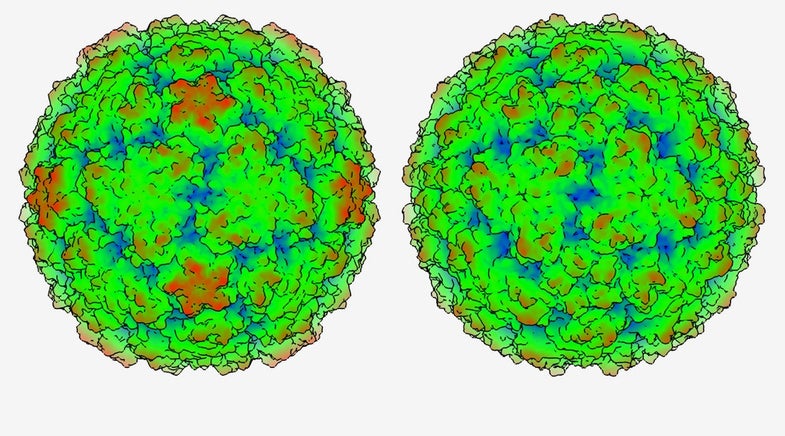Model Of Newly Discovered Common Cold Virus Species Looks Like A Booger
Meet human rhinovirus C.

What are these boogery-looking blobs? Well, they are, appropriately, models of the exteriors of human rhinoviruses, the viruses that give people the common cold. On the right is the first such detailed model of human rhinovirus C, one of three known species of the HRVs.
The new C model helps explain why it’s been so difficult to develop a cure for the common cold, according to the model’s creators. The scientists, a team of virologists from the University of Wisconsin-Madison, found that human rhinovirus C has surface features that are distinct from those on human rhinoviruses A and B. Scientists have long known about—and had x-ray crystallography images for—human rhinoviruses A and B. But the human rhinovirus C was only discovered in the past few years, as gene sequencing technology improved.
The model helps explain why it’s so difficult to develop a cure for the common cold.
Researchers have come up with drugs that work against HRV-A and HRV-B by attaching to surface structures on the viruses. Because HRV-C is different, however, the HRV-C modeling team hypothesized that’s why those drugs nevertheless failed to cure many colds. Surveys have found that up to 30 percent of colds are caused by HRV-C.
“We predict you’ll have to make a C-specific drug,” Holly Basta, a doctoral student in virology, said in a statement. Basta worked on the model with her colleagues Jean-Yves Sgro and Ann Palmenberg. “All the [existing] drugs we tested did not work.”
Basta and her team built their model from data from the genetic sequences of 500 human rhinovirus Cs. The model offers information on a virus species that’s been difficult to study: Scientists haven’t yet figured out how to grow HRV-C in labs for study, although they are able to grow HRV-A and HRV-B easily.
The team published their work in the journal Virology.